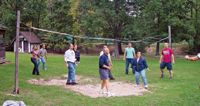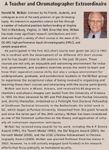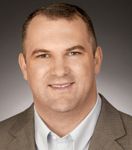Harold McNair: An Innovator in Gas Chromatography Research and Teaching
LCGC North America
An interview with Harold McNair reveals his greatest accomplishments and proudest moments.
Kevin Schug, of the University of Texas at Arlingto n, interviews Harold McNair, professor emeritus of Virginia Tech's chemistry department, about his illustrious career in chromatography.
Kevin Schug: Who introduced you to gas chromatography (GC)?
Harold McNair: Dr. A.J.P. Martin, Dr. Steve Dal Nogare, and Professor A.I.M. Keulemans. You could not have wished for a better group of mentors. In 1957, I performed my first GC injections. I was a graduate student at Purdue University (West Lafayette, Indiana) and had just finished a Masters degree in electrochemistry. I wanted an exciting new topic for my PhD work. I took a summer job at Amoco's Research Labs in Whiting, Indiana. My job was to screen around 80 new liquid phases for selectivity to separate butane-1 and isobutylene as well as some C18 unsaturated methyl esters. During that summer job, Nobel Laureate A.J.P. Martin came to the labs to install his new gas density balance detector.
I was assigned as his "gofor" for the day. It was a memorable experience; he really turned me on to GC with his knowledge, enthusiasm, and tips on making tea (heat the cup!). The next summer, I worked with Steve Dal Nogare from DuPont in Wilmington, Delaware, and was indoctrinated to temperature-programmed GC. Steve was a great mentor and very enthusiastic about GC. Finally, my Fulbright fellowship with Professor A.I.M. Keulemans in 1959 convinced me I would work on GC for as long as I could. So many of the pioneers in GC came to his laboratory and I was fortunate to work with many of them — and this fired my enthusiasm for GC.
Kevin Schug: What do you see as your greatest achievement in the field?
Harold McNair: My greatest achievement is collaborating with my students — undergraduates, graduates, and postdoctoral fellows — and visiting professors (easily more than 200 total). This group of intelligent, humorous, hard-working people made my research and teaching both interesting and challenging — most of the time! It would be unfair to mention any single individual as there were too many major breakthroughs from a wide range of people. Highlights would definitely include reporting the first capillary gas chromatography–mass spectrometry (GC–MS) results in 1961; introducing temperature programmed liquid chromatography (LC) in 1981; using mobile-phase modifiers to stabilize retention times on silica gel; developing the first directly coupled LC–GC experiment using two independent computers in 1981; identifying the role of pH in capillary zone electrophoresis (CZE) to add to the electrostatic mobility of highly hydrated protons; and also early work on analyzing steroids in urine by gas chromatography time-of-flight mass spectrometry (GC–TOF-MS). The latter study was one of the earliest demonstrations of the use of TOF-MS coupled to GC for determining traces of steroids in urine and this work was honored with an "outstanding PhD thesis award" from Virginia Tech (Blacksburg, Virginia).
A research project in 1976, which correlated pKb's of weak aromatic amines with retention time on acidic silica gel, was recognized by the National Aeronautics and Space Administration (NASA) as the second most cited scientific publication for that year. The Viking Mars Landing was number one! Our work was one of the first publications on the LC analysis of aromatic diamines. Not only did this class of compounds hold high interest for NASA in relation to polymer research, but they also held high biological significance; thus, many researchers in the biomedical and pharmaceutical communities also paid close attention to this work.

Figure 1: Red Lion Inn, Blacksburg, Virginia. McNair and his students versus HPLC short course students in a game of volleyball (1997).
But equally as important as the quality of the scientific publications was the work ethic, the group effort, and strong friendships I established while at Virginia Tech. Some of the best memories were the long van rides to Pittcon each year. I was always so proud when one of my students gave a great lecture at some conference. I am still in contact with almost all of my former students.
Kevin Schug: Did you consider entering academia after your postdoctoral fellowship?
Harold McNair: Not really. I was focused on industry. I had spent five summers working in industry at Phillips Petroleum Co., Amoco Central Research, American Cyananid, DuPont, and Esso Analytical R&D. I knew industry had better equipment, strong support staff and services, real significant problems, and, of course, much better pay. In fact, when I did come to Virginia Tech in 1968, my plan was to stay only a few years then go back into international marketing, hopefully in Europe, in the scientific instrument business. But after three years, I fell in love with teaching students, choosing my own research projects, and being able to play tennis almost any time and day. Blacksburg was a great place to raise a family.

Incidentally, I did actually get a tennis and a scholastic scholarship for the University of Arizona and played there for two years until the number of physics and chemistry labs every week left no time for tennis. I still enjoy hitting and try to play two or three times a week.
Kevin Schug: You told me that two of your favorite activities, teaching short courses and writing books, came from your industrial experience. Why is this?
Harold McNair: After one year with Esso R&D in 1961, I returned to Europe to set up operations for F&M Scientific (later H.P., Avondale, Pennsylvania). Even though Europe had introduced and pioneered the art of GC, there were few progressive instrument manufacturers. F&M Scientific and later Aerograph (Varian) realized the importance of temperature-programmed GC; both became major leaders in the field based on the quality of their instrumentation. I lived in Amsterdam from 1962 to 1964 and European customers were begging for seminars, hands-on training courses, booklets — anything to help them learn about GC. Part of my job was then, and still is today, telling everyone how great GC really is. My book Basic GC originated from a lecture at the University of Athens, Greece, in 1963. After one lecture, the faculty begged me to come back the next day. After four lectures in four days, they begged me to write up the lectures, which became the first draft of Basic GC. It is written in straightforward English for Europeans with English as their second language. It was a simple book, easy-to-read, and was eventually translated into eight different languages with more than 130,000 copies sold.
After joining Varian in 1965, I set up a one-person unit, GC training, which offered "hands-on" GC training, across the United States initially, but later in Europe, Canada, Australia, and Mexico. This was a huge success. The unit not only showed a small profit each year, but also, as I recall, about 20% of all attendees bought or had already bought a Varian GC system. It was a great marketing success.
Thus, logically, I carried the model for short courses and GC books with me to Blacksburg. The short courses helped train my students, generate money in my earlier academic career, recruit new graduate students, and several companies left their best chromatographic systems in my labs.
Kevin Schug: What do you see as the most exciting development in separation science at the moment or in the future?
Harold McNair: Liquid chromatography–mass spectrometry (LC–MS) applied to biological compounds. So many people who are not trained as chemists or chromatographers are buying and using LC–MS regularly to study important problems that involve the analysis of complex mixtures of biomolecules.
This article was first published in the November 2009 issue of LCGC Europe. The interview has been edited for length and clarity.
Kevin A. Schug received his PhD in Chemistry from Virginia Tech under McNair in 2002, performed postdoctoral research with Professor Wolfgang Lindner at the University of Vienna (2003–2005), and is currently associate professor in the Department of Chemistry and Biochemistry at the University of Texas at Arlington.

Kevin A. Schug
Research in the Schug lab spans the fundamentals and applications of liquid-phase separations, in conjunction with electrospray ionization mass spectrometry (ESI-MS). Additionally, ESI-MS is studied as a means for preserving and analyzing noncovalent complex formation between small molecules, while MALDI-MS is used for fingerprinting complex mixtures.
Schug was the recipient of the 2009 LCGC Emerging Leader in Chromatography Award, the 2009 Eli Lilly and Company Young Investigator Award in Analytical Chemistry, and an NSF CAREER award. Schug credits his research and teaching principles to his previous mentors: Harold McNair and Wolfgang Lindner. He currently manages a group of 21 graduate and undergraduates at the University of Texas at Arlington.

Understanding FDA Recommendations for N-Nitrosamine Impurity Levels
April 17th 2025We spoke with Josh Hoerner, general manager of Purisys, which specializes in a small volume custom synthesis and specialized controlled substance manufacturing, to gain his perspective on FDA’s recommendations for acceptable intake limits for N-nitrosamine impurities.
University of Rouen-Normandy Scientists Explore Eco-Friendly Sampling Approach for GC-HRMS
April 17th 2025Root exudates—substances secreted by living plant roots—are challenging to sample, as they are typically extracted using artificial devices and can vary widely in both quantity and composition across plant species.
Determining the Serum Proteomic Profile in Migraine Patients with LC–MS
April 17th 2025Researchers used liquid chromatography–mass spectrometry (LC–MS) in their proteomic analysis to compare the serum proteome of migraine patients with healthy controls and to identify differentially expressed proteins as potential migraine biomarkers.












